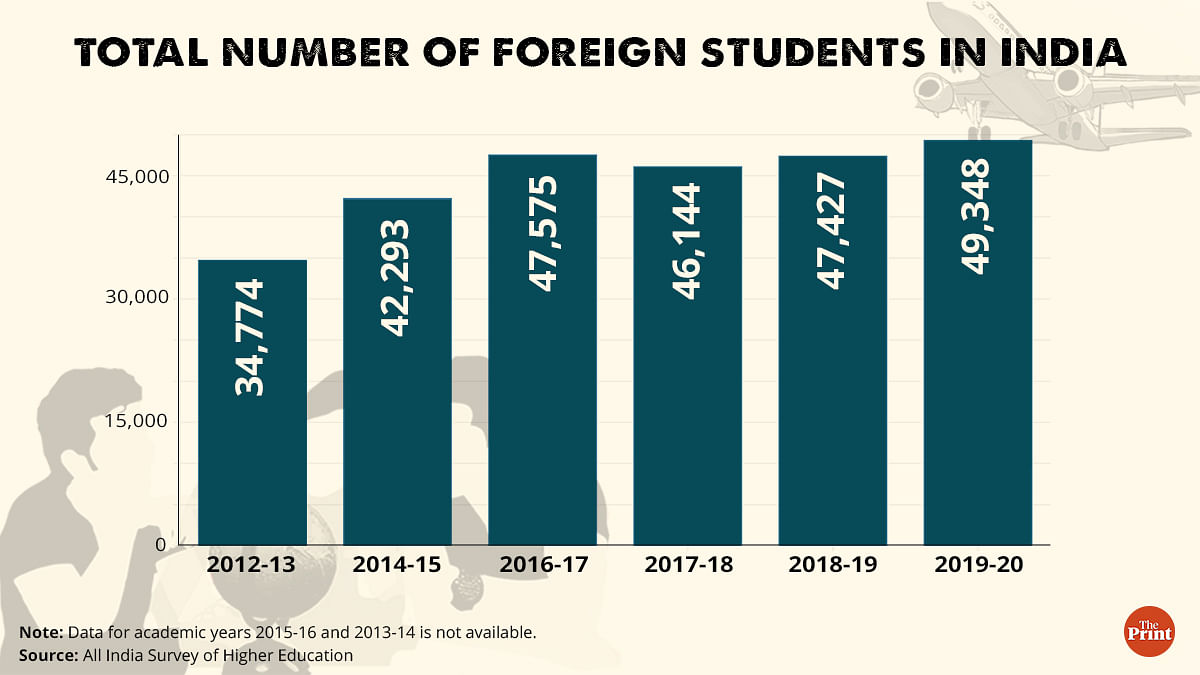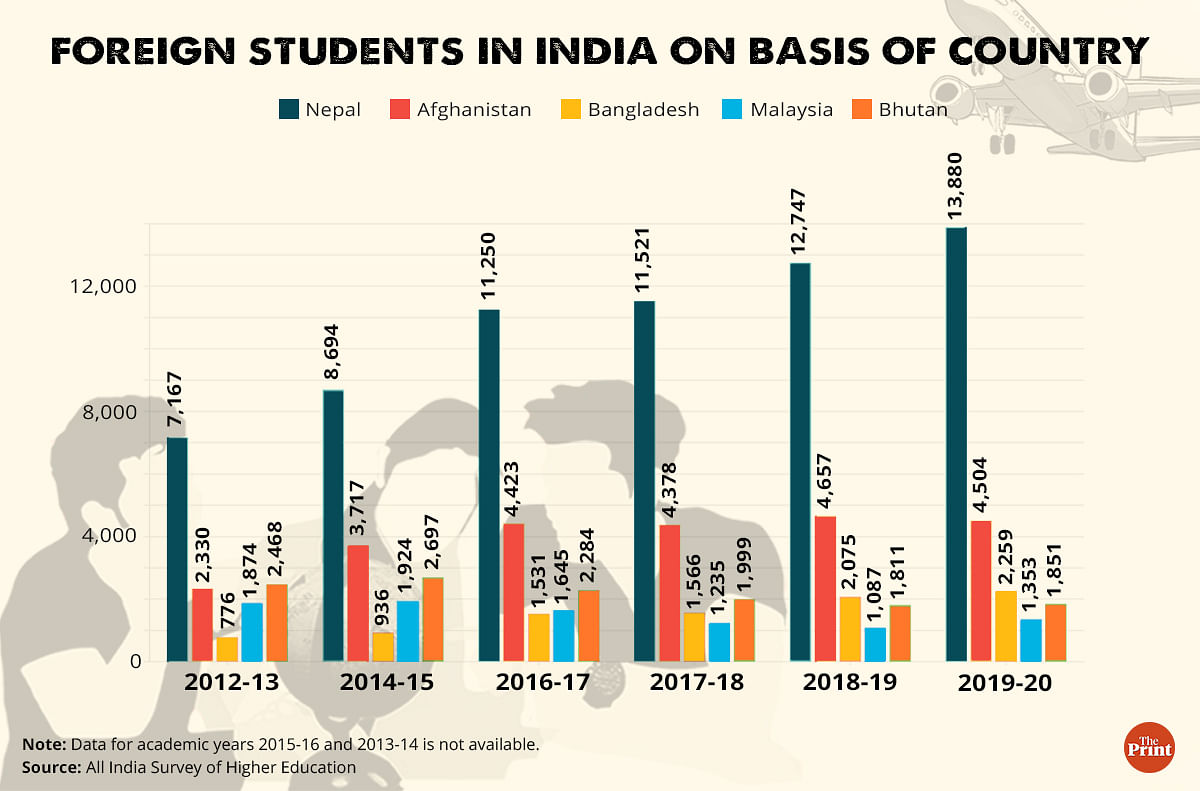New Delhi: The number of foreign students coming to India for studies has surged by nearly 42 per cent in less than a decade.
However, the countries that send students to India have remained almost the same over the years, with a large chunk coming from South Asian nations, and Nepal accounting for the largest share, data from the Indian government shows.
In fact, countries like Malaysia and Bhutan, which used to send a lot of students to India, have reduced their numbers after educational facilities improved locally.
According to data from the All India Survey on Higher Education (AISHE) for seven years — from 2012-13 to 2019-20 — the number of foreign students coming to India went from 34,774 in 2012-13, to 49,348 in 2019-20.
Analysis of data from the seven years shows that Nepal continues to send the largest number of students to India, followed by Afghanistan. The number of students coming from Bangladesh has gone up in the past two-three years, while the number from Bhutan and Malaysia has gone down. The intake from Iraq and Iran has also gone down in recent years.
The majority of foreign students coming to India enroll for undergraduate programmes, followed by postgraduate and then PhD, data shows. Only a handful come for certificate courses. Science subjects are preferred the most, followed by business administration. The number of students coming for humanities studies is low.
In 2019-20, of the total foreign students in India, 9,503 were enrolled in Bachelor of Technology programmes, followed by 3,967 in Bachelor of Science and 3,290 in Bachelor of Business Administration. The trend was observed to be similar in the preceding years.
While there is no data for the pandemic years of 2020 and 2021, the data till 2019 paints a clear picture of education opportunities in India.

Talking about the reasons behind the country-specific trends, Furqan Qamar, former secretary general, Association of Indian Universities, and currently a professor at Jamia Millia Islamia university, said: “For nearly two decades, foreign students coming to India have predominantly been from the South Asian countries and the reason for that is, we have a number of scholarships from the Indian Council for Cultural Relations (ICCR) for students from SAARC (South Asian Association for Regional Cooperation) nations.”
“Of late, scholarships for students from Bangladesh have gone up, which is why more Bangladeshi students are now coming to India. As far as Malaysia and Bhutan are concerned, both countries have more higher education institutions at home now. So fewer students are coming to India,” he added.
Amrit Das Kaur, a former officer at Foreign Students’ Registry at Delhi University, said that if India needs to attract more students from other countries, the modalities need to change.
“It is because of ICCR scholarships and the Indian government’s focus on the region that we get more South Asian students. The policies need to change if we want to attract more foreign students from other regions,” she said.
Also read: Forced into online exam is India’s opportunity to radically alter how we evaluate students
The statistics
In 2012-13, Bhutan sent 2,468 students to India but the number has steadily declined over the years with only 1,851 Bhutanese students studying in India in 2019-20. Similarly, for Malaysia, the number has gone down from 1,874 in 2012-13 to 1,353 in 2019-20.
On the other hand, 776 students from Bangladesh were studying in India in 2012-13, and this number rose to 2,259 in 2019-20.

According to a paper ‘Higher Education in Bhutan: Policy, Current Status, and Challenges’ by Kuenzang Gyeltshen and Rinchen Dorji in Bhutan, “within a period of about six decades, modern education system has expanded from about 11 schools prior to 1961 to 880 schools and other educational institutes in 2018, spanning from early childhood care education to tertiary and technical and vocational education.”
Likewise for Malaysia, the higher education system in the nation has a lot to offer to students now, with over 100 institutions in existence with branches in the UK, Ireland and other countries. The nation’s universities are also ranked high, between 100 to 200, in the QS World University Rankings.
Planning more seats
According to experts, there is no evident reason why India is not able to attract enough foreign students.
“There are no evident policy or regulatory barriers in attracting international students,” saud Qamar. “Besides (being given) permission to admit international students on a supernumerary basis, the higher educational institutions are also allowed to charge differential fees from international students to generate revenue.”
Supernumerary seats are those over and above the total enrollment in a programme.
“At the same time, they are also permitted to offer incentives like waivers, scholarships, and fellowships to attract international students,” he added.
An education ministry official associated with the Indian government’s ‘Study in India’ programme, which aims to attract more foreign students, said the nation gets a lot of interest from foreign students but the pandemic has made things slow.
When asked about attracting students from the US, UK, Canada or countries other than those in South Asia, the officer said: “We have seen students coming from US, UK and Canada for certificate programmes and programmes in languages. These are mostly students who want to either learn Hindi, Sanskrit, yoga, or some other traditional subject.”
This trend reflects in the data as well, as the number of students coming from the US to India has gone up in recent years. This number was 852 in 2012-13, and surged to 1,627 in 2019-20.
India’s University Grants Commission (UGC) recently asked all universities and colleges to create 25 per cent supernumerary seats for foreign students.
The total number of students in the Indian higher education system is 3.85 crore, according to AISHE, and if 25 per cent additional seats are created for international students, there would be space for 96 lakh foreign students.
However, with the number of foreign students enrolled in 2019-20 being just 49,348, India has so far not even got one lakh international students.
(Edited by Nida Fatima Siddiqui)
Also read: Unfit teachers, infra — 239 ‘unrecognised’ schools in Mumbai, but closure can put 5,000 kids at risk




